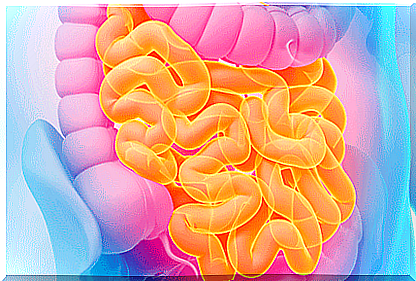Hirschsprung’s Disease
Hirschsprung’s disease (HD) or aganglionism is a congenital disease of complex inheritance in which several genes are involved. It affects approximately 1 in 5,000 newborns, being somewhat more common in males.
What happens is that there is an alteration of intestinal motility at the level of the last sections of the large intestine, the colon and the rectum. This alteration is due to the fact that the cells responsible for regulating intestinal movements have not been formed during development. As a result, stool evacuation is impaired, stool accumulates, and constipation develops.
About 30% of cases, Hirschsprung ‘s disease is associated with other congenital disorders. It is important to detect these anomalies since they are important in the prognosis and in the search for the genes involved. In 12% it appears in children with Down syndrome.
Pathogenesis of Hirschsprung’s disease

When the food we eat reaches the stomach, the gastric juice is released with which the digestion of proteins begins. Chyme is formed, which is a homogeneous substance that passes into the small intestine. Once there, substances that facilitate the absorption of nutrients continue to be released.
For the chyme to travel through the digestive tract until it reaches the anus, movements of the intestinal wall are essential, which drive the bolus to advance. These movements, called peristaltic movements, are muscle contractions and relaxations of the intestinal wall that push the chyme through the intestine.
The regulation of these movements is carried out by cells of the nervous system called ganglion cells. These cells are not only found in the intestine but are also in the esophagus and stomach, forming a complex nervous network known as the enteric nervous system.
In Hirschsprung’s disease, the ganglion cells of the large intestine have not formed during embryonic development, so there are no peristaltic movements that drive the fecal mass. As a consequence, these accumulate in the rectum and constipation occurs in the newborn.
In addition, certain bacteria can proliferate due to fecal stagnation and develop infectious conditions such as colitis.
Types of Hirschsprung’s disease
Depending on the section of the large intestine that lacks ganglion cells, different types of Hirschsprung’s disease (HD) are distinguished. They all have in common the lower end, which is the internal anal sphincter. In an upward direction, the extension of aganglionism allows differentiating between:
- Short segment Hirschsprung disease. It accounts for 80% of cases, in this case the affectation reaches the sigmoid area, which is the section of the large intestine immediately before the rectum. Within this type there is a variant called ultrashort segment Hirschsprung’s disease. In this case, only the last part of the rectum is affected.
- Long segment Hirschsprung’s disease. It affects 20% of patients and the absence of ganglion cells extends beyond the sigma. It can affect the entire colon ( colonic HD ) or even the entire intestine ( intestinal HD ).
Hirschsprung’s disease clinic

The manifestations of HD will depend on the intestinal surface affected and the possible complications. Symptoms usually appear in the first months of life.
In the first place, the clinical suspicion is given by the presence of constipation in the newborn. At birth, the nutrients that the baby has had during pregnancy are expelled in the form of meconium. This expulsion must take place in the first 48 hours of life.
90% of children with HD do not eliminate meconium in this interval. In addition, although the elimination of meconium is adequate, subsequent constipation is almost constant in children with this disorder. On the other hand, newborns will have a clinical picture of intestinal obstruction, characterized by:
- Vomiting
- Abdominal distention: the newborn’s abdomen swells due to fecal accumulation, which also increases the content of abdominal gases.
In some cases the symptoms are more serious, triggering a picture of enterocolitis, that is, an intestinal infection. This is due to the fact that abdominal distention alters the intestinal wall, in such a way that it facilitates the proliferation of microorganisms that will develop the condition. It is more common in cases associated with Down syndrome and can cause the death of the newborn. In this case it will appear:
- Fever.
- Lethargy, the level of consciousness decreases, so the child is not very reactive.
- Diarrhea, sometimes with blood.
- Abdominal distension.
Diagnosis
The diagnostic suspicion is given from the clinic that we have mentioned. From here, it is important to confirm the diagnosis to avoid complications such as enterocolitis. The tests used are:
- Abdominal radiography, which confirms the obstruction picture.
- Barium enema : provides much more information than radiography, since it allows you to see the extent of the disease. To do this, contrast is introduced anally and its distribution in the digestive tract is observed with imaging techniques. It allows to see the aganglionic segment, in which the intestinal wall is narrower. It also allows you to see the so-called transition zone, where the segment without ganglion cells ends. In addition, a control test can be done after 24 hours since there is usually a delay in the elimination of the contrast.
- Rectal manometry: this test allows to confirm the alteration of intestinal motility, since it measures the response of the muscles to different pressures.
- Biopsy: it is the test that confirms the diagnosis of Hirschsprung’s disease. A small sample of tissue is taken and analyzed under a microscope. If the child has Hirschsprung disease, there will be no ganglion cells.
Prognosis and treatment of Hirschsprung’s disease

Treatment consists of a surgical intervention in which the segment lacking ganglion cells is removed, then the healthy intestinal tract is spliced with the anus, to normalize fecal evacuation. Once operated, the prognosis is good although complications appear in half of the cases. Among the most common complications are:
- Enterocolitis, which, as we have said, is the leading cause of mortality in children with this disorder.
- Fecal incontinence, which usually returns to normal in the first year after treatment.
- Constipation, which may require control tests to rule out other associated intestinal disorders.
- Enuresis or urinary incontinence, which may require reoperation.
Summarizing…
As the MSD Manual indicates: “Hirschsprung’s disease is a congenital anomaly of the innervation of the lower segments of the intestine, generally limited to the colon, causing partial or total functional obstruction” and, fortunately, it can be repaired by surgery and it should be noted that the prognosis after the operation is good.








